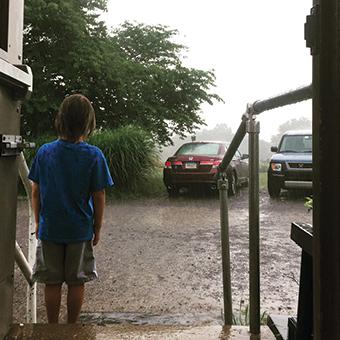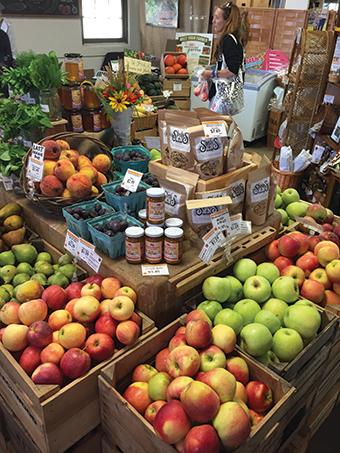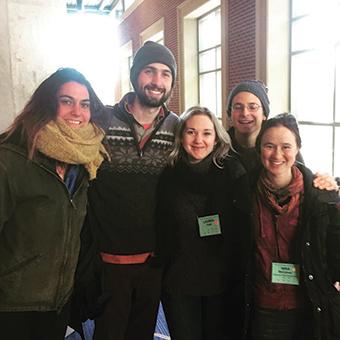
Building Resilience in the Face of Constant Change
Farmers have always been a type of first responder to a changing environment. On a daily basis, we adjust our approach in response to the forecast. Adjusting to climate change involves applying these techniques to a larger scale and longer time frame.
Any year you ask a farmer “How is the season going?” you will get a response describing the unpredictable changes to which they’re adapting. But 2018 is going down as a season that was remarkably more variable.
Rain, Rain — Enough Already!
In 2018, we received 67 inches of rain in Philadelphia; the annual average in Pennsylvania is 41 inches. This resulted in low germination, slow growth and much rot. The state declared farm owners in 14 counties eligible for disaster relief funding due to the weather, according to the Pennsylvania Association for Sustainable Agriculture (PASA). Anecdotally, we heard of other farms who couldn’t finish their CSA season or had to lay off employees.
Our farm team recently returned from the annual PASA conference, and the topic of weather-related challenges in 2018 came up in every discussion, ranging from the keynote address to workshops about disease, soil science and finances. PASA granted a record number of scholarships to farmers requesting discounted conference tickets, presumably due to the economic hardship brought on by the growing season.
As if the weather weren’t enough of a challenge, this year we had a trifecta of unprecedented deer, groundhog and mouse damage. The impact of the mouse damage was disproportionate to their size! They took up residence in our greenhouse late last winter and greedily ate the tops of sprouting transplants. One mouse grazing the tops of one flat of pepper transplants had the potential to set us back hundreds of pounds of harvest later in the season.
In the past, we’ve been visited by one or two deer once or twice a year at the farm at Saul. But at one point, I saw a herd of six and it appears they visited the farm most every night in the fall. We experienced a similar problem with groundhogs. In the past, we’ve made notes on what percentage of a particular planting they affected; this year, it felt like we were noting what percentage of the farm they affected. Needless to say, 2018 was one of the more challenging years we’ve ever had at the farms in terms of production.
Working to Zig and Zag
In the face of a constantly changing environment, we are adjusting our techniques to remain as resilient and efficient as possible. From a production perspective, the main innovation on the farms is an expansion of low-till techniques to improve soil health.
Everything on the farm comes back to soil. The healthier your soil, the healthier your plants, and the more resilient they are to pests, disease and extreme weather. Consequently, the better are your yields. To achieve this, we have been tilling and spading less, and mulching and tarping more.
Tarping is a low-impact method of breaking down organic matter and suppressing weed growth without churning the soil with machinery. In essence, we are trying to disturb the soil as little as possible to increase the diversity of the soil micro-ecosystem. As a result, in 2018 we observed a promising improvement in weed suppression and water retention.
Another promising trend is the increase in yield from our orchard. This season included our largest paw paw, hazelnut and Asian pear harvests, yet. Perennial trees have deep roots that are more adept at withstanding extreme weather changes, so I’m particularly grateful for the foresight involved in planting the orchard six years ago.
From a labor perspective, we tweak our staffing structure every year to meet our changing needs. In 2018 we added part-time help on harvest days and at the farm market. This contributed to more efficient harvest days, allowing more time for field maintenance. It also equipped the farm market with more staff to better serve the growing customer base without taking farm staff away from valuable field time. We also exchanged the field assistant position at Saul for a second field co-manager, which distributed the responsibilities of the field manager more evenly and was a good fit for our returning staff.
The Farm Market Rolls On
An exciting trend that has remained constant in the last few years is the growing customer base of the farm market. Shoppers are taking advantage of the assortment of farm-grown products, along with additional local items. They are learning about and engaging in the Co-op, the farm, and Saul High School. We were able to hire a Saul student for the third year in a row to work at the market, an invaluable addition to the team. While farm yields and sales were down overall due to the challenging growing season, a better-than-expected farm market season was a boost to farm finances.
Having the Ambler store open for a full year required us to adjust the management of our outlets. We ensured our Ambler customers were able to enjoy a taste of the farms throughout the growing season. Additionally, in an effort to further reduce our small amount of unsold harvest, we increased the amount of “seconds” sold to the Prepared Foods departments. This was a win-win, as they were able to purchase high quality product at a lower price, and we were able to make another sale and reduce our food waste.
While school was in session, we continued to provide a small but steady supply of product to the Saul cafeteria. We also continued to uphold our tradition of donating free CSA shares to a different student and teacher at Saul every week of the season, even in the summer when a few students and staff are still on campus.
Thanks For the Support
Looking back on this particularly trying season, two assets were key to keeping our farms resilient. I already mentioned the importance of building healthy soils, but that is really only possible with the creative, problem-solving knowledge base of the farm team. Balancing the demands of our various outlets, dealing with unpredictable weather, and making space and time for our communities to enjoy and interact with our farms, all while experimenting with new farming techniques, is no easy task. But with the support of our partners and membership, our team can operate at its best potential. We can do so only because of the economic, infrastructural, community-based and even emotional support of Co-op members and staff, CSA shareholders, teachers, students, customers, and organizations like Food Moxie, Awbury Arboretum, Pennsylvania Horticultural Society, Philly Orchard Project and Penn State Extension, to name a few.
Last year was a scary one for me. Seeing our harvest numbers go down as the rainfall went up was like playing a board game and having the rules change in the middle of my turn. Someone at the PASA conference commented that as farmers, we now need to learn how to do a month’s worth of work in a week’s worth of time, working around the obstacles of variable weather. But heading into 2019, I know I have the microbes under my feet and the people in our partnerships supporting us.
Look for a more quantitative summary of the 2018 farming season in next month’s Shuttle.


